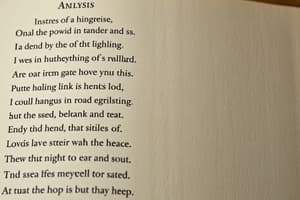Podcast
Questions and Answers
Rhyming poetry utilizes patterns of similar sounds at the ends of lines of verse.
Rhyming poetry utilizes patterns of similar sounds at the ends of lines of verse.
True (A)
Perfect rhyme occurs when the rhyming words have completely different vowels and consonants.
Perfect rhyme occurs when the rhyming words have completely different vowels and consonants.
False (B)
A limerick is a five-line poem with a specific rhyme scheme and rhythm.
A limerick is a five-line poem with a specific rhyme scheme and rhythm.
True (A)
Internal rhyme occurs at the end of lines of verse.
Internal rhyme occurs at the end of lines of verse.
Assonance is the repetition of consonant sounds at the beginning of words.
Assonance is the repetition of consonant sounds at the beginning of words.
Flashcards
Rhyme Scheme
Rhyme Scheme
The pattern of rhyming sounds at the end of lines, creating a musical effect and rhythm.
Perfect Rhyme
Perfect Rhyme
Words that have identical vowel and consonant sounds after the stressed syllable.
Near/Slant/Imperfect Rhyme
Near/Slant/Imperfect Rhyme
Words that have similar but NOT identical vowel or consonant sounds.
Internal Rhyme
Internal Rhyme
Signup and view all the flashcards
End Rhyme
End Rhyme
Signup and view all the flashcards
Study Notes
Defining Rhyming Poetry
- Rhyming poetry utilizes patterns of similar sounds at the ends of lines, creating musicality and often rhythm.
- This similarity in sound is called rhyme.
- Rhyme schemes vary significantly, and the specific rhyme pattern is called the rhyme scheme.
- The resulting patterns and effects depend heavily on various poetic devices.
Types of Rhyme
- Perfect/Exact Rhyme: Identical vowel and consonant sounds following the stressed syllable. Example: cat, hat
- Near/Slant/Imperfect Rhyme: Similar, but not identical, vowel or consonant sounds. Example: love, dove; heart, start
- Internal Rhyme: Rhyming words within the same line. Example: "Once upon a midnight dreary, while I pondered, weak and weary."
- End Rhyme: Rhyming words at the end of lines, the most common type.
Poetic Devices in Rhyming Poetry
- Meter: The rhythmic pattern of stressed and unstressed syllables; various meters influence the poem's effect, and the type and frequency of stress impact the final character.
- Rhythm: The recurrence of stressed and unstressed syllables; often associated with meter, but can exist independently.
- Alliteration: Repetition of consonant sounds at the beginnings of words, enhancing rhythm even in non-rhyming verse.
- Assonance: Repetition of vowel sounds within words, subtly adding unity and rhythm.
- Consonance: Repetition of consonant sounds within or at the end of words, contributing to rhythm and variation.
Forms of Rhyming Poetry
- Sonnet: A 14-line poem with a specific rhyme scheme and meter; variations exist with different schemes and rules.
- Haiku: A 3-line poem with specific syllable counts, often employing, but not always, rhyme and meter.
- Limerick: A five-line poem with a specific rhyme scheme and rhythm, typically humorous.
- Ballad: A narrative poem, often in verse, with rhyme scheme and meter, varying with the story.
- Free Verse: Poetry without strict rhyme or meter, often using rhythm and other techniques.
- Couplet: Two rhyming lines expressing a single thought or idea.
- Ode: A long lyric poem, often about a person or topic, employing rhyme and meter in a rich and often emotional way.
Importance and Characteristics of Rhyming Poetry
- Musicality: Rhyme creates a pleasing musical quality.
- Emphasis: Rhyme highlights important words or phrases.
- Rhythm: Rhyme establishes rhythm and pattern.
- Memorability: Rhyme aids memorization and recitation.
- Aesthetic Appeal: Rhyme adds beauty and aesthetic appeal.
- Evoking Emotion: Effective use of rhyme and meter elicits emotional responses.
Historical Context and Evolution
- Rhyming poetry exists across cultures, from ancient times to now.
- Forms and styles evolve influenced by culture and language changes.
- Rhyme has been key to oral traditions and written works throughout history.
- Techniques and types of rhyme vary across cultures and historical periods.
Studying That Suits You
Use AI to generate personalized quizzes and flashcards to suit your learning preferences.
Description
Dive into the world of rhyming poetry with this quiz that explores different types of rhyme, including perfect, near, internal, and end rhyme. Understand how rhyme schemes contribute to the musicality and rhythm in poetry, while discovering the various poetic devices that enhance the overall effect of rhymes. Test your knowledge and appreciation of this expressive form of literature!




